Dogs for sale
Pet Supplies
How to draw a dog
Join Our Dog Forum FREE!
Trendy Dog Clothes
Dog Supplies
Dog Forum
Dog Health
Dog Articles
Dog Posters
2010 Dog Calendars
Dog Cages
Portable Dog Crates
Electronic Dog Doors
Dog Kennels
Small Dog Clothes
Slow Cooker Recipes
Dog Leads
Pet Travel Guide
Toy Dogs Guide
Dog Supplements
Dog Medicine info
Dog Allergies
Dog Portraits
Dog Resources
Sitemap

The Bull-Terrier
- Bull terrier history
- Bull terrier breed description
- Bull terrier pictures
- Bull Terrier puppy pictures!
- Is a Bull Terrier for you?
- So you think you want a Bull Terrier?
- Bull Terrier Rescue
Author: Robert Leighton
The Bull-terrier is now a gentlemanly and respectably owned dog, wearing an immaculate white coat and a burnished silver collar; he has dealings with aristocracy, and is no longer contemned for keeping bad company.
Bull Terrier History
The “New Bull Terrier” first appeared in its present form at a Birmingham show in May 1862. It was shown by James Hinks, a dog dealer, who is generally accepted as the original breeder of the Bull Terrier, whose family has being associated with Bull Terriers until the present day.
The “New Bull Terrier” gained in popularity and in 1887, after several attempts,
The Bull Terrier Club was formed. At this time the breed consisted mainly
of white specimens, the coloured generally being of a different type. Shortly
after the 20th Century commenced, determined and successful efforts were made
to breed coloured Bull Terriers, today the coloured and white are one breed.
By Selective breeding the Bull Terrier has today developed into a companion animal and much loved family pet. He is extremely affectionate with people, and is particularly noted for a fondness towards young children.
Nevertheless he is a strong and powerful animal, and it should always be remembered that he is a first and foremost a Terrier with a competitive spirit and may not always be tolerant of other animals, though many live together in a household quite happily with other pets. As with all dogs, a Bull Terrier is a fairly rare breed I see 1 or 2 at the park where I walk Molly! And yes, a staffy cross and Bull Terrier are absolutely fine playing together, but bar that you may want to look at your options with regards to Bull Terrier Dog insurance.. It could save you alot of vets bills.
Back to Bull Terrier top
Bull-Terrier breed standard
The Bull Terrier Breed Standard
Background to the Breed
General appearance
Strongly built, muscular, well balanced and active with a keen, determined and intelligent expression.
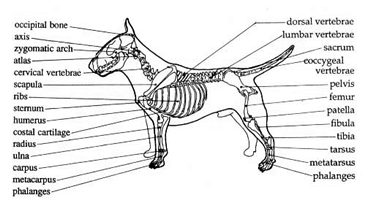
Bully Characteristics
The Bull Terrier is the gladiator of the canine race, full of fire and courageous. A unique feature is a downfaced, egg-shaped head. Irrespective of size dogs should look masculine and bitches feminine.
Temperament
Of even temperament and amenable to discipline. Although obstinate, is particularly good with people.
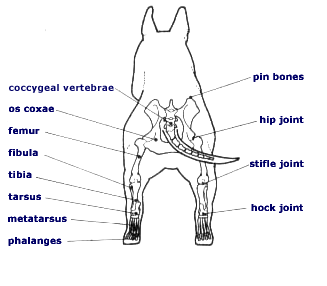
The skeleton of the Bull Terrier from behind

The skeleton of the Bull Terrier from the front
Head and Skull
Head long, strong and deep right to the end of muzzle, but not coarse. Viewed from front, egg-shaped and completely filled, its surface free from hollows or indentation. Top of skull almost flat from ear to ear. Profile curves gently downwards from top of the skull to tip of nose, which should be black and bent downwards at tip. Nostrils well developed and under-jaw deep and strong
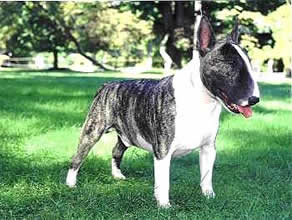
Mouth
Teeth sound, clean, strong, of good size, regular with perfect, regular and complete scissor bite, i.e. upper teeth closely overlapping lower teeth and set square to the jaw. Lips clean and tight.

Correct bite – scissors

Incorrect bite – undershot

Incorrect bite – overshot

Incorrect bite - pincer
Eyes
Appearing narrow, obliquely placed and triangular, well sunken, black or as dark brown as possible so as to appear almost black, and with a piercing glint. Distance from tip of nose to eyes perceptibly greater than that from eyes to top of skull. Blue or partly blue undesirable.
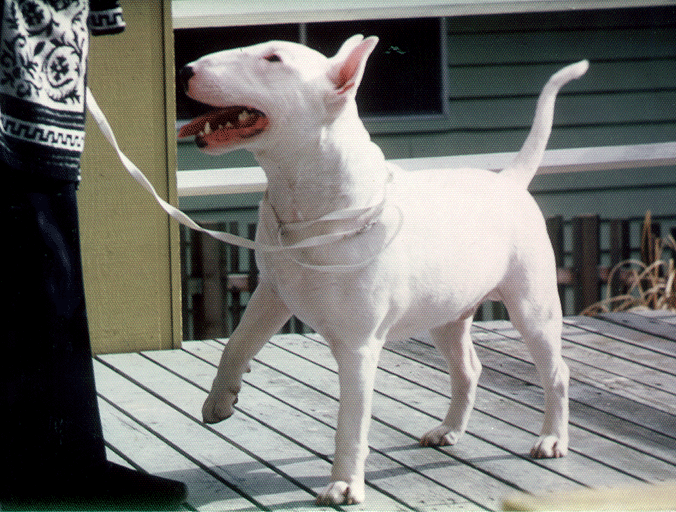
Ears
Small, thin and placed close together. Dog should be able to hold them stiffly erect. When they point straight upwards.
Neck
Very muscular, long, arched, tapering from shoulders to head and free from loose skin.

Upright placement of the shoulder. Note the effect of lengthening the back and shortening the neck. The outlines are identical

Upright placement of the shoulder. Note the effect of lengthening the back and shortening the neck. The outlines are identical
Forequaters
Shoulders strong and muscular without loading. Shoulder blades wide, flat and held closely to the chest wall and have a very pronounced backward slope of front edge from bottom to top, forming almost a right angle with upper arm. Elbows held straight and strong, pasterns upright. Forelegs have strongest type of round quality bone, dog should stand solidly upon them and they should be perfectly parallel. In mature dogs, length of foreleg should be approximately equal to depth of chest.

Correct placement of the shoulder and upper arm.

Pelvis too steep, stifle and hock too straight. Note the effect on the topline, and width of hindquarters.
Hindquarters
Hind legs in parallel when viewed from behind. Thighs muscular and second thighs well developed. Stifle joint well bent and hock well angulated with bone to foot short and strong.

Feet
Round and compact with well-arched toes.
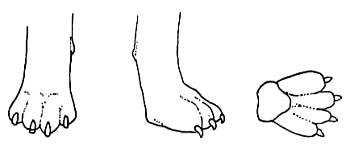

Tail
Short, set on low and carried horizontally. Thick at root, it tapers to a fine point.
Gait/Movement
When moving appears well knit, smoothly covering ground with free, easy strides and with a typical jaunty air. When trotting, movement parallel, front and back, only converging towards centre line at faster speeds, forelegs reaching out well and hind legs moving smoothly at hip, flexing well at stifle and hock, with great thrust.
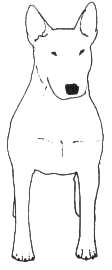
Excellent front. Note that the hind legs are in parallel with the front legs
Coat
Short, flat, even and harsh to touch with a fine gloss. Skin fitting dog tightly. A soft textured undercoat may be present in winter.
Colour
For white, pure white coat. Skin pigmentation and markings on head not to be penalised. For coloured, colour predominates; all other things being equal, brindle preferred. Black, brindle, red, fawn and tricolour acceptable. Tick markings in white coat undesirable. Blue and liver highly undesirable.
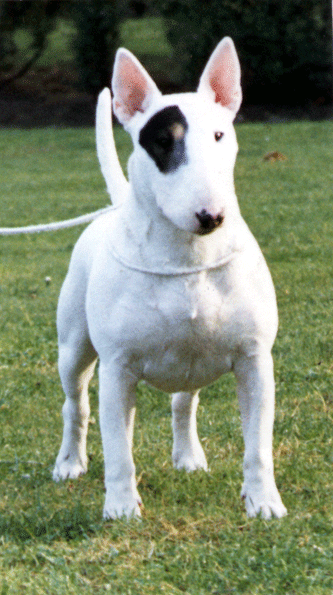
Size
There are neither weight nor height limits, but there should be the impression of maximum substance for size of dog consistent with quality and sex.
Faults
Any departure from the foregoing points should be considered a fault and the seriousness with which the fault should be regarded should be exact proportion to its degree.